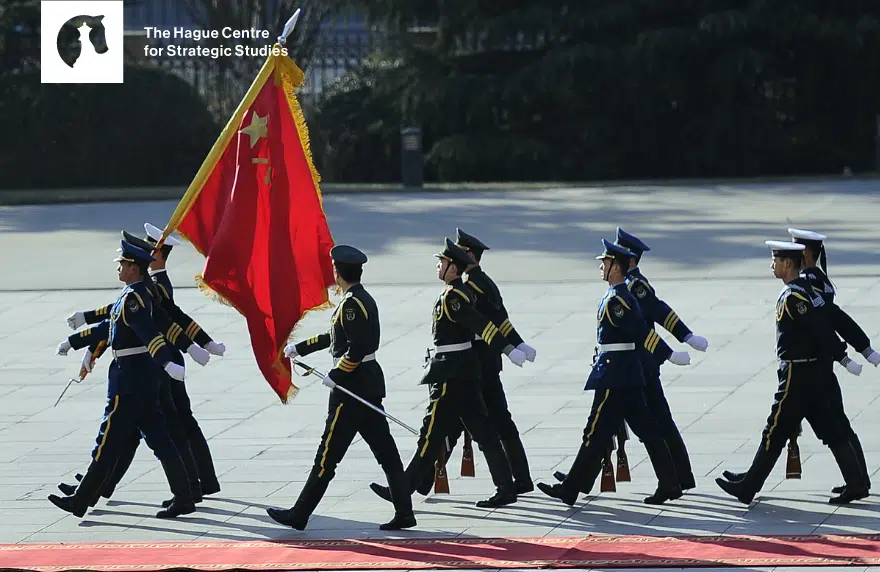Research
China is following a typical trajectory for rising great powers in terms of its increasing willingness and ability to project power outside its region. What is the People’s Liberation Army capable of today and what will likely be its capabilities by 2035? This new HCSS report makes a broad assessment of China’s military modernization and the implications for the security of European states, providing 20+ policy recommendations to deal with China’s military rise.
It is increasingly difficult to have a dispassionate understanding of Chinese military power. For many, China is already an ideologically incompatible and unstoppable juggernaut; for others, it is unlikely to ever entirely match Western military capabilities. Also, China’s ability to project power within the South China Sea, East China Sea, and Taiwan Strait has been the focus of most analyses. As a result, there is a lack of a comprehensive assessment of the overall development of China’s military capabilities and what these will mean outside of the Western Pacific, especially for European states.
This report addresses the gap by developing a typology based on historical examples of other rising powers. The publication goes in depth on China’s military power, provides an analysis of how it arrived at current capabilities, and the trajectory through 2035. The ultimate objective of this analytical approach is the development of an evidence-based foundation for thinking about the potential consequences of China’s military rise and European and Dutch policy options to address it.
The main finding of the report is that China exhibits almost all of the factors that characteristically drive great power expansion outside of the region. It is following a typical rising great power trajectory in almost all respects, although it is still on an upward path, and is implementing a long-term strategy to be able to project power extra-regionally, which it is expected to be increasingly able to between now and 2035.
Download the full report, the annex or the individual chapters:
READER’S GUIDE
| Chapter | Title | Main questions | Authors |
| 1 | How Great Powers Rise: Extra-regional Dynamics, Motives and Manifestations | What are the motivations that drive the military rise of great powers? What are the manifestations of the military rise of great powers? What is the extra-regional impact? | Lotje Boswinkel, Tim Sweijs, Paul van Hooft |
| 2 | The PLA’s Role under Xi’s Core Interests in Great Rejuvenation: Global Power Beyond the Western Pacific | Who and what drives China’s security policy? What are the regional and global implications of China’s ambitions? | Michael Shoebridge (ASPI) and Ming Shih Shen (INDSR) |
| 3 | China Outside the Western Pacific: Military Capabilities for Power Projection | How has China expanded its capabilities to project power outside of its own region, first and foremost in the Indian Ocean and its adjacent waters, between 1996 and 2021? Which factors may impede the further development of China’s military capabilities? | Joris Teer, Juliëtte Eijkelkamp, Paul van Hooft |
| 4 | China Outside the Western Pacific: Resources to Sustain Power Projection | How has China expanded its means to sustain power projection, for instance through overseas bases, port investments, infrastructure, alliances, arms transfers and operational experiences, outside of its own region? What means does China have to further expand its power projection capabilities? | Joris Teer, Juliëtte Eijkelkamp, Paul van Hooft |
| 5 | An Assessment of China’s Military Rise | How can China’s rise as a military great power 1996 and 2021 be assessed? What will be its likely trajectory between now and 2035? | Joris Teer, Tim Sweijs, Jack Thompson |
| 6 | The Consequences and Implications for European Security | What are the direct and indirect consequences for European security of China’s rise as a military great power? What are the policy implications of China’s rise as a military great power for European foreign and security policies? | Joris Teer, Tim Sweijs, Jack Thompson |
| Annex | – | Joris Teer, Juliëtte Eijkelkamp and Paul van Hooft |
The research for and production of this report has been conducted within the PROGRESS research framework agreement. Responsibility for the contents and for the opinions expressed rests solely with the authors and does not constitute, nor should it be construed as, an endorsement by the Netherlands Ministries of Foreign Affairs and Defense.
Great power competition has once again become the most important consideration for Western security policy. The behavior of a number of states are of concern for Western policymaker, including Russia. However, the focus is on China. With this in mind, HCSS launches the report on China where an assessment of its military rise and impact on Europe will be published over the coming weeks.
By providing a comparative historical analysis of the rise of great powers, the first chapter lays the groundwork for the subsequent empirical chapters. It seeks to identify broader patterns in motives and manifestations when it comes to the deployment of military power outside the home regions of great powers.
The chapter concludes with the following Key Takeaways:
- Historically, great powers have emerged through multifaceted and multi-decade trajectories that fuel competition with other states. They are responsible for the majority of interstate conflict, both between great powers and with lower-level powers.
- Great powers pursue military expansion to augment security, maintain access to or obtain resources, to satisfy domestic interest groups, and to bolster prestige. These drivers are not always rational from the perspective of outside observers.
- Small or middle powers tend to think of security in terms of territorial defense or extended defense; in contrast, great powers, by virtue of the outsize role they play in the system, are concerned with the global balance of power.
- Great power extra-regional influence consists of projection capabilities, developing and maintaining sound infrastructure, establishing bases, fostering alliances, transferring arms to other states, or engaging in military-to-military cooperation.
The second chapter analyzes the core interests that the Chinese Communist Party (CCP) has outlined in recent decades and which the CCP has been acting to secure since Xi has taken power. It examines the focal points of bureaucratic debates between the Party and the Chinese government as well as the role that the People’s Liberation Army (PLA) may play in upholding the Party’s articulated – and growing – ‘core interests’.
Chapter Two was produced by Michael Shoebridge, Director of the Defence, Strategy and National Security Program at the Australian Strategic Policy Institute (ASPI) in partnership with Ming Shih Shen, a senior researcher at the Institute for National Defense Security Research (INDSR).
It assesses that the CCP’s Great Rejuvenation of Chinese People is Beijing’s national goal, with military power being a means to this end. In addition to these geographic areas, Beijing’s plans are creating a PLA with increased power projection and presence in space, cyber space, and the electromagnetic spectrum, areas unconstrained by geography which provide options for exerting Chinese power globally – to ‘safeguard China’s security interests’ and to ‘safeguard China’s overseas interests’. The authors focus on the priorities among Xi, the Party, bureaucrats and the PLA of these ‘core interests’ as well as the expectation flowing from these for the PLA’s role and its functions.
The authors assess the following takeaways as most important:
- China is following a typical trajectory for rising great powers in terms of its increasingly willingness and ability to project power outside its region.
- China’s objective of being able to project power beyond the Western Pacific is closely linked to the domestic political agenda of President Xi Jinping and the security concerns of the Chinese Communist Party, both of which will remain powerful influences on Chinese strategic thinking for the foreseeable future.
- China increasingly treats the South China Sea as its own territory; this will be a drain on Chinese defense resources, but it will also provide a foundation for projecting power outside the region.
- Chinese strategic planning assumes that China needs to project power beyond the Western Pacific to protect its economic, political, and military interests in the Indian Ocean, Middle East, and Africa.
- Chinese policymakers believe that what they view as a declining West, led by the United States, will not be able to prevent China from projecting power in the South China Sea and beyond the Western Pacific already by 2027, at which point they believe China will possess a world-class military.
In order to illustrate how and why it has chosen to develop various military capabilities, the third chapter analyzes China’s defense spending. The assessment starts in 1996, continues to the present day and projects trends to 2035. The chapter is devoted to the broad spectrum of China’s military capabilities relevant to its ability to influence events in the Indian Ocean: China’s far seas military capabilities such as its extra-regional power projection capabilities and long range strike capabilities; command, control, communications, computers, intelligence, surveillance, and reconnaissance (C4ISR); and additional capabilities.
The chapter concludes with the following Key Takeaways:
- In response to the end of the Cold War and demonstrations of unmatched US power in the 1990s, China undertook a rapid and ambitious modernization and expansion of its military and accelerated progress in the last decade. Today China is the dominant force in its own backyard, gradually pushing US power projection capabilities away from its coast.
- China has developed almost all capabilities necessary for regional power projection and is in the process of developing extra-regional capabilities. China is on the verge of a breakthrough and will be able to effectively project power extra-regionally within the next ten years.
- China possesses a world-class missile arsenal and fleet of surface support ships, but still trails the most advanced Western militaries in terms of the number and sophistication of aircraft carriers and the capabilities of its carrier strike groups (CSGs), specifically in areas such as jet fighters and anti-submarine warfare.
- China is undertaking enormous efforts to remedy the shortcomings in its CSGs and will narrow the gap with the most advanced Western militaries by 2035.
- Towards 2035, demographic, economic, political, technological and security developments may impede the continued development and maintenance of especially China’s far seas military capabilities and to a lesser extent its near seas capabilities.
This chapter examines the resources that underpin power projection outside of China’s own region in the Western Pacific, including defense spending, concrete capabilities and procurement. It also analyzes the diplomatic and defense activities that support extra-regional military engagement.
The resources that China has to sustain power projection beyond the Western Pacific, and specifically in the Indian Ocean, remain limited in some respects. However, China can already draw upon an enormous collection of assets and is following a long-term strategy that, on current trends, may soon allow it to sustain power projection capabilities outside its region.
Key Takeaways for chapter four are:
- Though China faces severe hurdles in its efforts to sustain power projection beyond the Western Pacific, it commands enormous resources and is following a long-term strategy designed to support long-term power projection capabilities outside its region.
- Efforts to overcome shortcomings in its ability to sustain power projection are boosted by China’s enormous industrial resources, including by far the largest ship-building capacity in the world giving the PLA a distinct advantage in a protracted conflict. It also has a large and modern defense industry, is the world’s fifth largest arms exporter, and has a quasi-monopoly on critical raw materials. The relatively small number of supply ships it has to support military operations abroad could be, when necessary, supplemented by a massive reserve fleet of vessels controlled by Chinese SOEs.
- China lacks (in)formal alliances but instead has initiated a large number of business-first strategic partnerships. The deep and broad apolitical commercial relationships it has created, may challenge American and European alliances and serve as the foundation upon which a future alliance system can be built.
- China is in the process of supplementing its strategically-located base in Djibouti – in East Africa, near the Middle East – with access to and influence over sites in Pakistan, Bangladesh, Myanmar, and Sri Lanka that may in the long run be used for military purposes.
- China has sought to limit the downsides of its dependence on oil supplies from the Middle East by forming constructive relationships with Iran, Saudi Arabia and other oil-producing states; over which it wields influence in a “buyer’s market” whilst avoiding entanglement in the region’s political problems and military conflicts.
Referring back to the framework provided in Chapter One, this component of the report synthesizes the key findings of Chapter Two, Three and Four. In examining motivations and manifestations of China’s military rise, it evaluates where China was (1996-2020), where it is now (2021) and where it is projected to be (2021-2035).
China is exhibiting all of the factors that typically drive great power expansion outside of the region. It has shown signs of most of the motivations for expansion that great powers typically exhibit and has made enormous strides in its stated goal of developing a world-class military, though it stills falls short in some key areas. In short, it is following a typical trajectory for a rising great power, even though it lacks behind in some key aspects that enable the use of military capabilities far from home, and is implementing a long-term strategy to be able to sustainably project power outside its region.
The chapter focuses on the six aspects that make up of extra-regional military capabilities:
- the development of extra-regional power projection capabilities;
- the maintenance of sound infrastructure;
- the establishment of overseas and overland bases;
- the conclusion of formal and informal alliance relationships with other states within multilateral or bilateral frameworks;
- the transfer of arms and other military equipment;
- the extension of military aid through various forms of military-to-military cooperation.
China’s emergence as a great power has had profound and increasingly pressing consequences for the security of European states, even though the focus of China’s military rise – its near seas – seems remote. The consequences include those that are direct, such as the risk of Sino-US conflict in China’s near seas, to those that are indirect, such as growing Chinese economic influence over states that house European naval bases.
The final chapter of the report on China’s military rise identifies the key security implications for European states. These include:
- the risks associated with kinetic conflict;
- increasingly frequent hybrid operations;
- a future PLA ability to project power in the far seas;
- China’s world-leading industrial resources;
- China’s expanding influence over third states.
22+ recommendations for European policymakers are provided, that are designed to mitigate the security consequences of China’s military rise. These range from minimizing the risk of wars fought close to China’s shore, to improving access to shipbuilding and repair capacities, to expanding access to critical raw materials and to working with oil importers to offset China’s influence over oil-producers.









